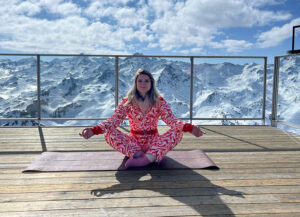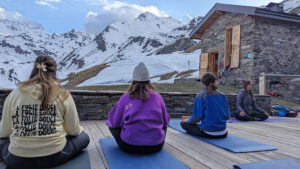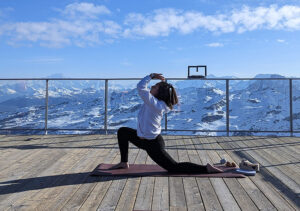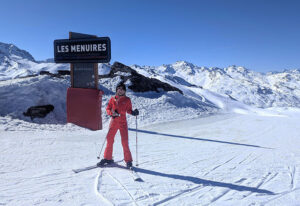Monica Meade explores apres-ski the wellness way as she tries out skiing for the first time during a trip to Les 3 Vallées.
Shifting from downward dog into a low lunge, I was met with 2,800m-high panoramic views of the snow-topped French and Italian Alps.
Thirteen of us were on an open-air wooden platform at Point de la Masse in Les 3 Vallées for an 8.30am full-body wakeup led by yoga instructor – and black-slope baddie – Axelle.
 “So, this morning’s dynamic class is all about preparing our bodies to move for the day – whether that’s skiing, hiking or whatever else,” Axelle said. Steadying myself on one foot with the other pressed against my inner thigh, I felt a niggle in my quad from the previous day’s ski lesson. Relaxing into the tree pose, the tightness began to ease as I gently deepened my stretch with each exhale.
“So, this morning’s dynamic class is all about preparing our bodies to move for the day – whether that’s skiing, hiking or whatever else,” Axelle said. Steadying myself on one foot with the other pressed against my inner thigh, I felt a niggle in my quad from the previous day’s ski lesson. Relaxing into the tree pose, the tightness began to ease as I gently deepened my stretch with each exhale.
When it was time to finish up, as I rolled away my yoga mat, I noticed my muscles and joints felt like they’d been doused in WD40. And I was extremely switched on for someone who hadn’t had a morning coffee yet.
Axelle was born in the mountains, where she started skiing at the age of three. Even though the sport comes as naturally as walking to her, she’s found her skills have vastly improved in her 10 years of being a yogi. “In yoga, we practice proprioception, which is all about how you use your body in the world, like coordination and balance,” Axelle said. “And in skiing, that’s half of it. We also use a lot of breath work, and in every sport you need a good connection with your breath. That’s why a lot of professional athletes now use yoga to help with their biking or running, for example, because it’s super complementary.”
On this trip I was spending the week finding zen between the icy chaos of attempting a winter sport for the first time. At least once a day I had a wellness workshop, either in Saint Martin or Les Menuires – there were 25 to choose from, most of them free to sign up for, as part of Belleville’s annual, end-of-season YogiSki week.
On day one, ahead of my first-ever ski lesson, I had a morning Vinyasa yoga class with Caroline Perrineau. I didn’t know it yet, but it prepared me for one of the most common hurdles as a rookie on the slopes.
“Fear has a bad reputation,” Caroline said. “But it’s good to remember that it also helps our evolution – it’s how we grow.” After watching her demo, I leaned onto my elbows and forearms to create a sturdy base for a headstand. Even though I’ve done much scarier things in my life, as soon as I started bunny hopping my legs into the air, pangs of tension flushed through me. My adrenaline system had kicked into action, just like Caroline said it would.
But unlike jumping out of a plane, I had complete control over when I wanted to induce the natural fear response. Between each kick of my legs into the air I focused on slow, calm breathing to slow my heart rate – keeping it at the front of my mind as they became closer to vertical above my head. “If we can face our fears and even enjoy the process, by having fun, then we can build strength from it,” Caroline said.
An hour later, when I was faced with a blue run minutes after figuring out how to clip into my skis, my entire body was rigid. Melted snow at the base of the piste meant I didn’t get to learn the basics in a practice area. But my ESF ski instructor Emilien Herbert had a lot of blind trust in me. “Just relax and let go of your upper body,” Emilien said. Having just worked on releasing unease from my body, it ended up being easy to stay fairly chilled. During the wobbly moments, I killed off any angst by laughing at how ridiculously clueless I was.
 Instead of a boozy apres-ski followed by poor quality sleep, I headed for a sound bath – snuggled in a blanket with a weighted, lavender-scented eye mask, I melted into the yoga mat in the dimly lit room with a soothing, glowing red light. Instructor Sophie Fraçois circled us while delicately creating abstract melodies with her metal gong and chimes. Apparently, the vibrations from the gongs help to slow down your heart rate, reduce blood pressure and increase the production of feel-good hormones – snapping you out of the fight or flight state we spend most of our lives in.
Instead of a boozy apres-ski followed by poor quality sleep, I headed for a sound bath – snuggled in a blanket with a weighted, lavender-scented eye mask, I melted into the yoga mat in the dimly lit room with a soothing, glowing red light. Instructor Sophie Fraçois circled us while delicately creating abstract melodies with her metal gong and chimes. Apparently, the vibrations from the gongs help to slow down your heart rate, reduce blood pressure and increase the production of feel-good hormones – snapping you out of the fight or flight state we spend most of our lives in.
It definitely did something to me, as the next thing I knew, the sound of my own chuckling had woken me up from whatever nap or zoned-out meditative state I had just been in. By 10pm I was back at the chalet, in bed. Usually it takes one night of tossing and turning before I adjust to sleeping anywhere new, but that evening I was out for the count a soon as I shut my eyes.
 The next day, while racing a fellow Bambi on ice at a group beginner ski lesson, gravity took the wheel and I was a helpless passenger hurtling down a hill with the grace of an abandoned shopping trolley. I was moving far too quickly for someone with no skills – which was the thought that went through my head that finished me. I absolutely stacked it, landing flat on my back. It took a moment to process that I was ok before breaking into hysterics. After that, I remembered to relax whenever I felt like I was about to lose it – focusing on holding myself properly rather than the possibility of falling.
The next day, while racing a fellow Bambi on ice at a group beginner ski lesson, gravity took the wheel and I was a helpless passenger hurtling down a hill with the grace of an abandoned shopping trolley. I was moving far too quickly for someone with no skills – which was the thought that went through my head that finished me. I absolutely stacked it, landing flat on my back. It took a moment to process that I was ok before breaking into hysterics. After that, I remembered to relax whenever I felt like I was about to lose it – focusing on holding myself properly rather than the possibility of falling.
One group lesson later, I was smashing blue slopes alone. Granted, I hit the ground a few times per run, but it was always with a grin on my face. I was shocked at how quickly I got the hang of it all. Techniques from daily yoga – which improved my balance, core strength and beyond – I could easily bring with me onto the slopes while everything was fresh in my mind and muscle memory.
And that, alongside the fresh mountain air, hearty meals made with locally-sourced ingredients and a day at the brand new Belle Vie Spa in Saint Martin, I came away from the experience feeling fresher, stronger and more flexible than when I’d arrived.

Leave a Reply
You must be logged in to post a comment.